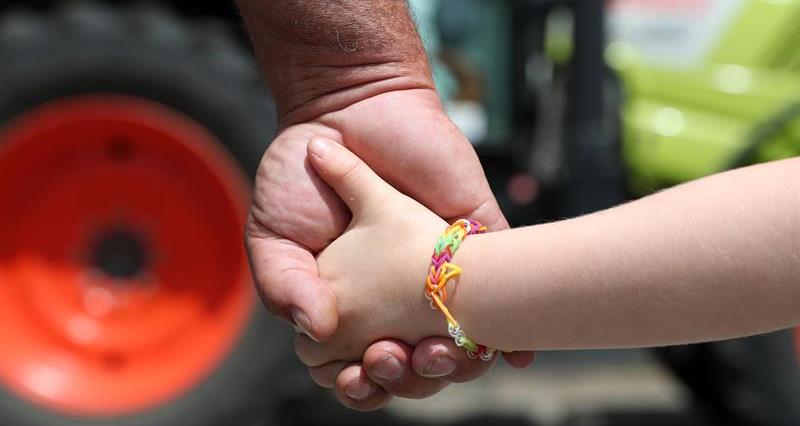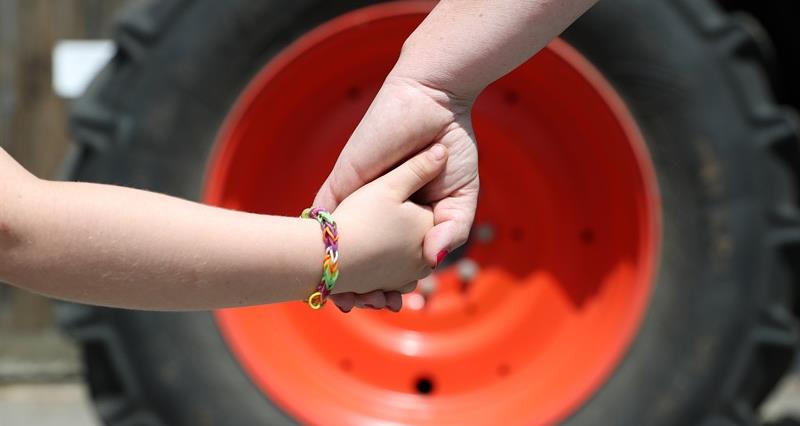Key points:
- Children should not be allowed in the farm work place (and for young children they should enjoy outdoor space in a secure fenced area).
- Any access to the work area by children under 16, for example, for education or knowledge experience, should be planned and fully supervised by an adult not engaged in any work activity.
- Children under the age of 13 years are specifically prohibited from driving or riding on any agricultural machine.
Your responsibilities
Everyone in a farm workplace has a responsibility to protect children who are vulnerable because of their age and physical and mental immaturity. Every employer is required by law to manage risks.
Children must be kept away from significant risk and where risks exist they must be very carefully managed and controlled. Normally this means children (under 16) are not in the workplace. If they are taken in to the workplace they must be fully supervised. If they are taken in to the workplace they must be fully supervised and if given tasks these must be simple and appropriate for their maturity and capability Guidance on managing risk is available on the HSE website.
As well as a legal responsibility to protect children, there is a moral responsibility to protect and nurture children.
Watch this hard-hitting video by the Wales Farm Safety Partnership
Older children
Guidance on what a child between the ages of 13 and 16 years may be able to do and most importantly cannot do on farm is available on the HSE web site.
No two children are the same in their physical and mental maturity and capabilities. This means that what a child is allowed to do or not do must be assessed on an individual basis. The law says that children should not be allowed to perform work beyond their physical or psychological capabilities or which is inherently dangerous. Many farm activities fall into the inherently dangerous category.
Risk assessments for the whole of the work place which take into account an individual child’s characteristics must be completed. A one size fits all approach is not acceptable.
Remember the work children are allowed to carry out must be individually assessed and will differ from child to child according to individual capabilities.
Vehicles and machinery
These present the greatest risk to children and are probably the areas of farm life most attractive to older children. The following are risks for which there are specific legal duties.
Prohibition on driving vehicles and machines
It is illegal to allow a child under 13 to ride on or drive agricultural self propelled machines (such as tractors) and other specified farm machinery while it is being used in the course of agricultural operations or is going to or from the site of such operations.
Prohibition on children riding on machines, vehicles or implements
It is illegal to allow a child under 13 years old to be carried on a tractor, self-propelled agricultural machine, or a machine or implement mounted on, towed or propelled by a tractor or other vehicle, including a machine or agricultural implement pulled by an animal, usually a horse.
Allowing young children to ride in the cab of agricultural machinery is unsafe and illegal. Children are not safe simply because they are in a cab – they can and do fall from cabs through doors which open accidentally, rear windows, or during emergencies. When they get out of the cab they are vulnerable to being run over by the machine as it moves off. Children can also present a risk to operators when they leave the driving position (e.g. to open gates) by working controls such as parking brakes, hydraulic levers etc, and they can distract the operator’s attention in an emergency.
It is illegal to allow for children under 13 years old to operate farm vehicles or machinery
Children over 13 may under certain tightly controlled circumstances operate some farm machinery to carry out lower risk tasks. The tasks should be risk assessed and the children should be properly trained and supervised by a competent adult. Any machinery used should be fully maintained with all guards and safety devices fitted and in working order.
Children are attracted to machinery and often fail to appreciate the dangers involved. Agricultural machinery that is used without anyone in attendance is therefore a particular risk. Keep unaccompanied children away from farm activities, and make sure that:
- all machinery is properly guarded;
- you do not allow children to help you – a moment’s lack of attention can result in tragedy.
- you do not leave a child in, on, or near machinery, including tractors etc.
ATVs
All-terrain vehicles (ATVs or quad bikes) are considered to be self-propelled agricultural machines when they are used in agricultural operations. It is therefore illegal for them to be driven for work by children under the age of 13. In addition, manufacturer’s minimum age recommendations also prevent children under 16 years of age from using most adult-sized machines. It is also illegal to carry a child as a passenger. More information on the safe use of ATVs is available on the HSE website.
Falling objects
Children might be naturally curious about what happens on the farm and want to know more. However, children should not be allowed into farm workplace by themselves. There are many risks in the farm yard. Falling objects such as bales or risks of falling from height for example from bale stacks, roofs or unsecured items such as ladders are just two. If children are taken into the farm workplace, it should be by an adult who understands the risks on the farm and is able to properly and fully supervise the child. The adult should not be engaged in any work activity. Their sole focus should be on supervising the child. Also make sure that you plan the visit to avoid busy times or high-risk areas.
If you take a child on to the farm, look for possible fall risks beforehand. Consider:
- making fixed ladders inaccessible by blanking the rungs (e.g. by securing a scaffolding plank across them)
- removing portable ladders (including any removable lower section of a fixed ladder) so that they cannot be used to get into dangerous areas
- storing portable ladders so that they are chained/secured to prevent unauthorised use
- stacking bales, pallets etc. so that children cannot climb up to otherwise inaccessible structures
- locking or otherwise securing buildings with high machines or equipment in them.
If a bale stack can be climbed, the key risks to consider are:
- falling from and through the bale stack
- keep children away from bale stacks
- the stack may be used to access other areas
- crushing by falling bales
- small bales used to make dens which may collapse
- fire – consider ignition sources.
Animals
Animals do not need to be aggressive to cause serious harm to, or even kill, a child. The dangers of mature cattle and horses are obvious, but sheep or pigs have caused serious injury, often when apparently playful.
The best way of reducing the risk from animals is to keep children away from them, or to allow controlled contact only when they are directly supervised by an adult. If you take young children to see animals in the field make sure that they stay close to you and do not wander off among the animals.
Although there are good educational and developmental reasons for encouraging children to have contact with animals, never allow children, even when with an adult, to enter pens or loose housing. Children should not be allowed into pens where animals are kept. Apart from the obvious safety risks especially the risks associated with large or aggressive animals, there are also zoonotic risks.
If you want to show children young animals, make sure that both the animal and the child are outside the pen, or secure or remove the mother from the pen.
Keep children out of the farm workplace entirely unless it is planned, properly controlled and the child is directly supervised by an adult who is not engaged in any work activity – the sole focus of the adult should be on supervising the child.

Where to find more information
Visit the HSE website for more guidance
Contact the Wales Farm Safety Partnership for free farm signs





